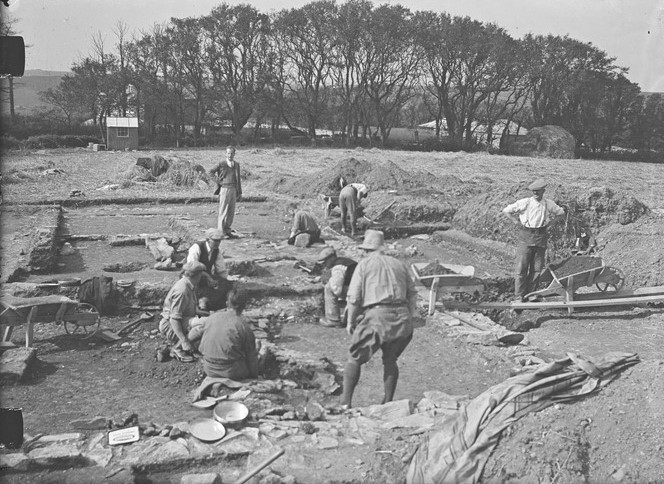Ertach Kernow - Recording and preserving Kernow's milestone legacy
Cornish milestones not something many people consider these days. With today’s big green signs pointing the direction with numbers for the major roads and small black and white for those local destinations little concern is shown for these small historic stones. Thankfully some people do and for many years Ian Thompson a retired teacher dedicated his time to researching, repairing and restoring historic milestones throughout Cornwall.
Looking at Cornish milestones one has to firstly consider those from the earliest times. The first milestones were erected during Roman times and as recent discoveries have proved, through archaeological work on the A30 improvements, the Romans did operate in Cornwall. There are five known milestones which have been found in Cornwall but none of these appear to have been part of a network of paved Roman roads. However, there is increasing evidence over just the past few years that Roman activity in Cornwall was far greater than originally believed. The importance of tin and Cornwall’s position as integral to a European maritime trade may have been the reason milestones or waymarkers (these are now more properly known as honorific wayside pillars}*
had been erected in specific places, albeit on tracks not normally considered a typical Roman road. Roman milestones or markers are more often a stone pillar with Latin inscriptions giving the name of the emperor reigning at that time. Pewter had become a popular metal alloy during the Roman period as it was far cheaper than silver but more durable than pottery. It contained about thirty percent lead and seventy percent tin, hence the importance of Cornish tin production to the Roman way of living.
There is no particular evidence that the Roman’s conquered or even occupied Cornwall to a major degree. For some time, believed to have been centuries, Cornish tribes had been trading with overseas merchants for tin. Perhaps the local tribal leaders and Romans came to a mutually beneficial trading agreement. There was little else here besides metals and the cost of invading and holding Cornwall would have been uneconomic. Forts have been discovered in Cornwall along with the milestone waymarkers, maybe these were also trading stations.
As always click the images for larger view
At Tintagel, now inside St Materiana’s Church, there is a Roman milepost with the inscription ‘IMPCG VAL LICIN’. This indicates the emperor at the time it was originally erected was Caesar Galerius Valerius Licinianus and dated CE308 to CE324. This milepost when first identified was found built into the church lychgate where it had been used as a coffin rest. When recognised as a stone of historical significance it was brought into the church for safety.
A second stone found in the Tintagel area is found at Trethevey. This is inscribed ‘C DOMI N GALLO ET VOLUS‘ the full translation reading ‘For the Emperor Caesars our lords Gallus and Volusian’ which dates the stone to CE251 to CE253 the period of joint rule of Gallus and his son Volusian. This stone was discovered in 1919 and was also being used as a gatepost and can now be seen fixed on the roadside with a plaque. That two stones have been found in this area indicates, as is now far better recognised, that Tintagel was an important place for trading. Although no paved Roman roadway has been found it is likely that a substantial track was in existence at that time.
Mynheer Farm located between Redruth and St Day is the location of a granite Roman milestone dated to between CE238 to CE244 discovered in a field in 1942. It now stands in the private garden at the farm. The Latin inscription states, ‘IMP CAES ANT GOR DIA NO PIO FEL’ and as usual an abbreviation. This in full reads ‘imperatorinus caesaribus Antonius Gordianus pio felicitas’ translated to `for the emperor, caesar, Antonius Gordianus pious fortunate’. Many will recognise this area as one of high mineral production during the 18th and nineteenth centuries and no doubt would have been so during the Roman period also. Indications are that there is a buried Roman road or at least a trackway lying about one meter below the present surface of the field with the stone being discovered standing near vertically just below ground level.
The first of two further Roman milestones found in west Cornwall can be found in the church at St Hilary. This was discovered in 1853 built into the 14th century foundations of the church. Somewhat more verbose than other stones it reads ‘Imp Caes Flav Val Constantino Pio nob Caes divi Constanti Pii F(el) Aug(usti) filio’ the letters in brackets are missing but assumed in the translation. Dated quite precisely to between CE306 and CE307 it is dedicated to the emperor Constantine the Great on the death of his father before his own elevation to the rank of Augustus.
Not too far away is the Roman milestone held in the church at Breage. This was discovered in the early 1920’s by the then vicar Reverend H R Coulthard and was being used as a gatepost. Thankfully he had the stone removed to the churchyard where it was inspected and translated by R G Collingwood who at that time was a leading authority on Roman Britain. Although the lower part has flaked away over the centuries the abbreviated translation would read ‘For the Emperor Caesar, our Lord, Marcus Cassianius (Latinus Postumus … .)’ This dates the stone to the years CE258 to CE268.
Centuries passed by before there were milestones erected again in Cornwall and mostly, but definitely not all, relating to the road improvements made through the Turnpike Trusts from 1754 onwards. It is these that form the bedrock of Cornwall’s nearly 700 fantastic milestone, fingerpost and waymarker legacy, believed overall to be one of the finest collections in the world. It is these that Ian Thompson has so assiduously worked to record and preserve.
Bert Biscoe the former mayor of Truro and Cornwall Councillor has contributed the following piece with his thoughts on Cornish milestones and as a well-deserved tribute to Ian Thompson.
‘When I was serving as Transport portfolio on the Cornwall Council cabinet, I became interested in the history of the road in Cornwall. I had read Paul Broadhurst’s speculations about roads, when seen from space by interested ‘parties’, depicting the shapes of creatures from Celtic astrology. I had also read of Goldsworthy Gurney’s battles with vested interests in Turnpike Trusts. I had read of Henry Quick, the Zennor poet, accepting commissions to carve milestones. I knew that Macadam had been the chief engineer of Truro Turnpike Trust.
One day, I was asked if I supported a small grant and material support being offered to the Milestone Society to map and refurbish milestones and fingerposts. It was then that I first met Ian Thompson. A lean, very intense man with a highly tuned mind and a mission – for, in Cornwall, Ian was (and remains) The Milestone Society. His proposition was very modest – he wanted to be trained to work on the highway; he needed white paint and black paint, and he wanted a small amount of money to survey, map, repair and promote milestones and fingerposts.
I realised as we spoke that I was so used to seeing (and using) milestones and fingerposts that I didn’t realise they existed, let alone that they were at risk of accidental destruction and long slow corrosion. Ian told me about what he had already gleaned of the history of the Cornish road network, mainly from the writings of Miss E Philbrick.
Ian set about his work and recruited one or two helpers along the way. With support from CORMAC Cornwall’s milestones began to be restored, to the enhancement of the landscape, roadscape and happiness of many.
* An addendum from Ian Thompson
Ann Preston-Jones and Mary Beard agree that the Roman 'milestones' in Cornwall were never set up at one mile intervals like the 18th century turnpike milestones. They were individual stones, set up to commemorate a particular, usually very short-lived, emperor. The politically correct term for them is not 'milestone', but 'honorific wayside pillar' since their purpose was to praise the work sponsored by the emperor, before his own troops killed him or he met some other sudden end.
The much-lamented Twelveheads Press published ‘Cornish Milestones’ in 2013, Ian having produced this useful very well researched and beautiful book – an index of road furniture in Cornwall. It is dedicated by him to ‘the highway workers of the eighteenth and nineteenth centuries who built the roads and erected the milestones’. It is a major work and is a lasting achievement of a quarter century or so of dedicated service by one man to his cause.
Ian and his wife Marilyn have now moved to England to be closer to their family. He will retain the Milestone Society role, but as a distant observer rather than as a directly engaged ‘highway worker’, historian, conservator and champion. Perhaps the milestones of Cornwall could provide restoration projects for Old Cornwall Societies, Parish Councils and others – WI’s, churches, Scouts and Guides, U3A. Milestones and fingerposts are an attractive and highly legible means of knowing where you are and finding where you’re going.
I am writing this partly to alert people to the need to continue Ian’s work, but also, importantly, to thank him for his dedication, skill, energy, intelligence and commitment to the milestones and fingerposts – small bits of a much bigger picture, but essential and characterful – people like Ian are few and far between. Let us offer heartfelt gratitude to Ian Thompson and wish him and Marilyn well in their venture to a foreign land! And let’s think about milestones!’
With such a vast number of milestone and waymarkers scattered throughout Cornwall more than one further article will need to be written to do them justice. I fully endorse Bert’s tribute to Ian Thompson and the hopes that more localised groups and individuals will take an interest in these historic monuments helping preserve them far into the future.













